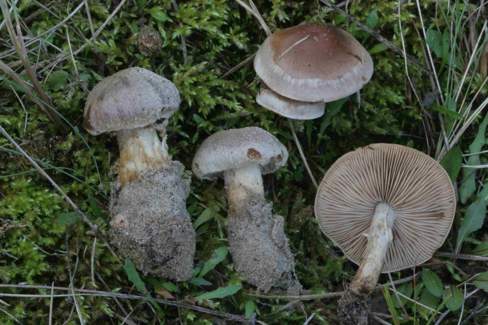 Hebeloma psammophilum (Photo: H. J. Beker)
Hebeloma psammophilum (Photo: H. J. Beker)Taxonomy
Full name: Hebeloma psammophilum Bon, Doc. Mycol. 16 (62): 70 (1986)Genus: Hebeloma
Section: Hebeloma
Subsection: Hebeloma
- arrow_drop_downarrow_drop_upNomenclatural notesReplacement name for Hebeloma psammophilum Bon (1980) [“1979”].
Basionym:
Hebeloma fastibile f. ammophila Bon, Bulletin trimestriel de la Société Mycologique de France 86 (1): 133 (1970)
Types: FRANCE: Somme, Le Crotoy (approx. 50.2167°N, 1.6258°E, alt. approx. 0 m a.s.l.) on sandy soil in dune under Salix repens, 10 Nov. 1969, M. Bon (90832) (Holotype. held at herbarium LIP, HJB1000026).
Homotypic synonyms:
- Hebeloma ammophilum (Bon) Bon, Documents mycologiques 9 (35): 41 (1980) ["1979"]
- Hebeloma psammophilum Bon, Documents mycologiques 9 (35): 91 (1980) ["1979"]
- arrow_drop_downarrow_drop_upEtymologyThe original epithet was “ammophilum” from ammophilus– sand loving. However, this name was invalid, having already been used, so it was changed to the alternative word with the same meaning, psammophilus.
- arrow_drop_downarrow_drop_upDiagnosisA typo differt habitatione in thiniis sabulosis inter arbusculis (Salix repens Hippophaeque) et cystidii ventricosis ad acies lamellarum.
References
Description
- arrow_drop_downarrow_drop_upThresholds
Description of Hebeloma psammophilum based on 14 collections
- arrow_drop_downarrow_drop_upMacroscopic descriptionPileus: (32) 37–64 (90) mm diameter; shape often broadly umbonate, occasionally convex or strongly umbonate; characters often remains of universal veil; margin characters involute; viscosity tacky when moist; colour variation often unicolour, occasionally two color; colour at centre occasionally clay-buff, ochraceous or dark brick.
Lamellae: attachment often emarginate, occasionally adnate; maximum depth up to 5 mm; number of complete lamellae 50–64; presence of tears absent; white fimbriate edge occasionally weak, absent or present.
Cortina presence: yes.
Stipe: (45) 53–79 (100) x (8) 11–12 (15) {median} x (8) 11–13 (18) {basal} mm; stipe Q 4.1–6.7; base shape often clavate, occasionally cylindrical, sand bulb, subbulbous or tapering; floccosity fibrillose, occasionally floccose at apex or pruinose at apex; rooting often yes, occasionally no; thick rhizoids at base absent;
Context: Texture firm; stipe interior hollow, often stuffed or superior wick; stipe flesh discolouring usually no, occasionally weak; slenderness measure 6.9–8.7; smell occasionally odourless, fruit or weakly raphanoid; taste weakly bitter, often mild or weakly raphanoid where recorded.
Spore deposit colour: brownish olive.
Exsiccata characters: Not recorded.
- arrow_drop_downarrow_drop_upMicroscopic descriptionSpores: shape ellipsoid, occasionally ovoid; colour in microscope occasionally beige or yellow pale, rarely brown, yellow or yellow brown; guttules no. papilla no; Spore Code: O1; P0; D0 D1.
Basidia: (22) 24–41 x 7–10 μm; ave. Q 3.2–4.2; spore arrangement Not recorded;
Cheilocystidia: main shape lageniform or ventricose, rarely cylindrical; special features observed often septa, occasionally apical thickening, rarely clamped septa, many collapsed in exsiccata or sparse; cheilocystidia ratios: A/M = 0.81–1.24; A/B = 0.46–0.80; B/M = 1.41–2.35.
Pleurocystidia: none seen.
Ixocutis: epicutis thickness (measured from exsiccata) up to 180 μm; ixocutis hyphae width up to 10 μm; ixocutis hyphae encrustation yes; shape of trama elements beneath subcutis often thickly sausage-shaped, occasionally isodiametric or thinly sausage-shaped up to 25 μm wide.
Caulocystidia: Similar to cheilocystidia but larger, up to 150 μm.
- arrow_drop_downarrow_drop_upSpore measurements
- arrow_drop_downarrow_drop_upCheilocystidia measurements
- arrow_drop_downarrow_drop_upHabitat and distributionHebeloma psammophilum's preferred habitat appears to be coastal dune or dune with sandy soil. Where only one possible associate was recorded, the most commonly recorded associate was Salix (66.7%) but Pinus (33.3%) were also recorded. In these cases the most commonly recorded families were Salicaceae (66.7%) and Pinaceae (33.3%). Overall the most commonly recorded families are Salicaceae (61.5%) and Pinaceae (30.8%) The growth habit of our collections was scattered.
According to our current collections, the species is found only in Europe. On the continent, collections have been found only in the European Atlantic mixed forests WWF ecoregion The World Wildlife Fund (WWF) have divided the world into 867 terrestrial ecoregions. The ecoregion here is estimated by mapping from the GPS coordinates of the collection using data made available by Dinerstein et al (2017). Use this webtool to explore the ecoregions visually or see a full list of current ecoregions on Wikipedia. (temperate broadleaf & mixed forests biome). From collector information, it appears collections have been found only in the 13.3 Coastal Sand Dunes IUCN habitat We map from the collector's description of the habitat to the International Union for Conservation of Nature (IUCN)'s definition using a standardised set of rules. Please see this page for a full list of IUCN habitats.. Within Europe we have records from the North (Denmark and Wales) and the Southwest (France). Specimens have been collected from 50.2°N to 57.7°N.
- arrow_drop_downarrow_drop_upMolecular resultsHebeloma psammophilum is nested within H. mesophaeum. It is monophyletic in the single locus results of ITS, the protein coding loci (as far as we can tell; we do not have many collections recent enough to amplify single copy loci) and in the result of the five-locus dataset and receives bootstrap support ≥ 80%. We did not manage to amplify any DNA of the type. There appear to be no published ITS data from this species.
- arrow_drop_downarrow_drop_upCommentaryWith the persistent presence of a cortina and the lageniform or ventricose cheilocystidia, this taxon clearly belongs in H. section Hebeloma. Within this section, with primarily indextrinoid or indistinctly dextrinoid ellipsoid spores, although some may be ovoid, and spores greater than 11 μm long and at least 6.5 μm wide and growing with Salix repens or Pinus in dunes, this species can only be confused with H. dunense. However, the latter is usually far more slender and has a discolouring stipe. Hebeloma psammophilum is quite robust with stipe width at least 8 mm; it also has more than 50 full length lamellae (L) and the spores look very smooth even under high magnification. Furthermore, H. dunense tends to occur in the pans (dune slacks) of the dunes, whereas H. psammophilum is in the shifting dunes.
Geographic distribution
Phenology
- arrow_drop_downarrow_drop_upAdditional cited collections